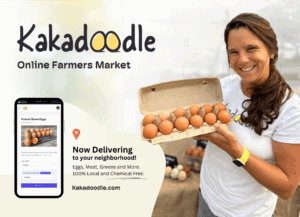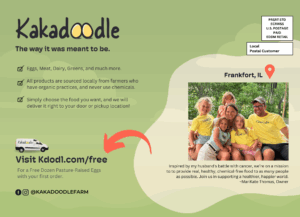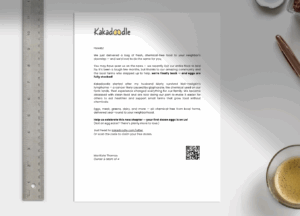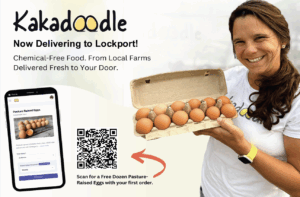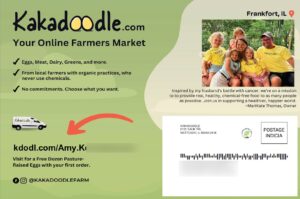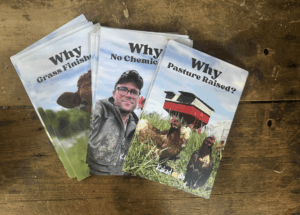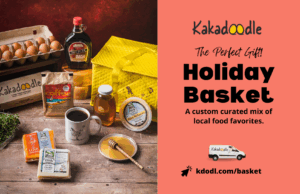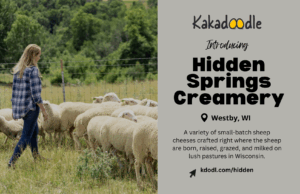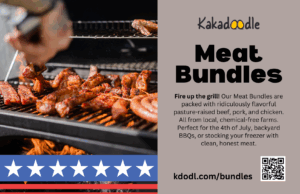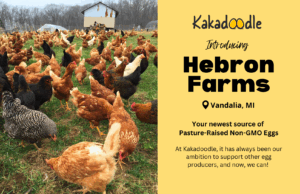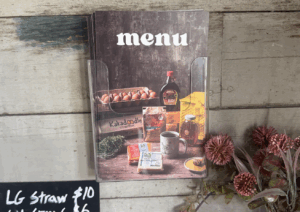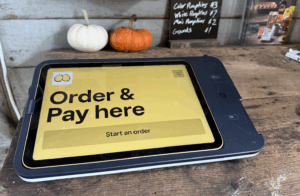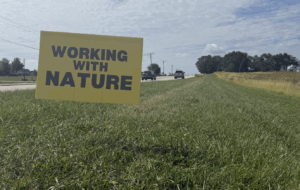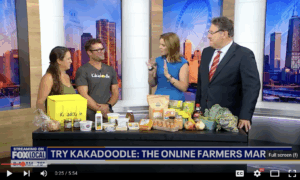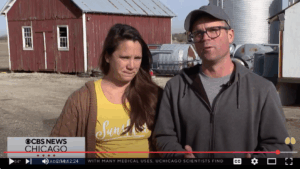Final report for FNC24-1438
Project Information
Kakadoodle is an "online farmers market" that makes it incredibly easy for our community to go online, purchase food from local farms, and have it delivered right to their door. We produce the eggs ourselves and partner with other local farmers for everything else on the marketplace, including meat, greens, dairy, and more.
Kakadoodle's farm and distribution center, where we process eggs and aggregate products from other farms, is located in the southwest suburbs of Chicago on 74 acres. We moved to this farm in January 2024 with 1,000 hens. After being conventionally farmed for centuries, we are in the process of establishing new pastures with the goal of integrating multiple species for grazing to enhance soil health and biodiversity, ultimately supporting our online marketplace—the economic engine of our entire operation. The vision for this land is to be a showcase for regenerative agriculture, reconnecting the community with the land, animals, and their food like never before.
Our farm sits right at the edge of the Chicago metro area, surrounded by a population of over two million people within a 25-mile radius. We intentionally focus on a tight delivery zone—roughly a 15-mile radius across Will, Cook, and DuPage Counties—to keep routes efficient and maintain strong local relationships. This dense population base makes outreach strategies like direct mail, roadside signage, and farm-stand traffic highly effective, in ways that might differ for farms in more rural regions.
MariKate and Marty started Kakadoodle in 2021 when they moved onto their 5-acre homestead with a vague idea to use technology to make local food more accessible. Their experience with cancer gave them the courage to uproot their family from their modern suburban home and move into a 150-year-old farmhouse, where their farming adventure began.
We tested several ways to build a customer base for a multi-farm, collaborative marketplace in our peri-urban setting, including direct mailers, flyers, roadside signage, and different displays. The grant let us test out which marketing methods were worthwhile, and what growth in our customer base was possible. We have seen an increase in customer trust (measured by repeat customers); number of farms collaborating and increased sales for those farms; and increased sales (and therefore jobs) overall (details, including financials, below).
Our project focused on helping our community discover the benefits of supporting regenerative farmers through education and a dedicated marketplace. Many people weren’t fully aware of the advantages of regenerative farming, such as healthier soil, reduced carbon emissions, more diverse wildlife, and better-tasting food.
Even for those who knew the benefits, finding regenerative products was challenging. Farmer’s markets had limited availability, operating only part of the year, and it was hard to verify whether supermarket products came from regenerative sources. Without a centralized marketplace, consumers struggle to support regenerative agriculture confidently, leading to skepticism about food sourcing and sustainability.
Our goal was to make regenerative products easily accessible year-round and educate the community on why supporting regenerative practices mattered. By showing how these products benefit both people and the planet, we are empowering the community to make informed choices that positively impact everyone.
Our primary goal is to educate and empower our local community about the benefits of regenerative farming while making regenerative food conveniently available year-round. We aim to provide our community with opportunities to reconnect with the land, animals, and their food through both education and the creation of a collaborative marketplace.
Teaching Methods and Materials:
-
Direct Mail Educational Campaign: We will launch a direct mail campaign featuring newsletters and brochures that outline the benefits of regenerative farming, and encouraging them to purchase from our marketplace. By reaching residents directly, we aim to ensure that everyone has access to valuable information about sustainable practices.
-
Community Engagement at the Farm: To deepen community involvement, we introduced a self-service farm stand where visitors can interact with our chickens and learn about regenerative farming through informational posters and brochures. This farm stand serves as a welcoming space for people to engage with our farming practices firsthand.
-
High-Traffic Location Advantage: Our farm’s location on a busy road has allowed us to draw attention to regenerative agriculture. We've strategically placed signs along the property to raise awareness and encourage passersby to stop by the farm stand, creating further opportunities for education and community connection.
Sustainable Agriculture Practices:
- Regenerative Techniques: Through our YouTube channel and conversations with farm-stand visitors, we actively promote and demonstrate regenerative practices as we transform our conventionally farmed land into a showcase regenerative farm.
- Local Food Systems: By establishing our collaborative marketplace, we emphasize supporting local farmers, which helps reduce food miles, lower carbon emissions, and bolster the local economy. All products featured come from regenerative farms.
- Reducing Food Waste: Investments in infrastructure like refrigerators and display shelves help preserve the freshness of products and minimize waste, aligning with sustainable agriculture's goal of reducing resource use.
Project Objectives:
- Community Education: Educate at least 4,500 community members through direct mail, on-site visits, and marketplace materials, ensuring they understand the benefits of sustainable and regenerative agriculture.
- Increased Awareness: Ensure community members gain greater knowledge and appreciation of sustainable practices, measured through post-initiative surveys.
- Access to Regenerative Products: Provide year-round access to regenerative products for the southwest suburbs on Chicago.
- Sustainable Purchasing: Encourage at least 60% of marketplace visitors to regularly buy regeneratively sourced products, tracked through sales and surveys.
Through these strategies, we aim to empower our community with knowledge, access, and the motivation to support regenerative farming, fostering a stronger connection to the land and their food.
Research
What We Did
Display Freezers and Refrigeration
We purchased upright display freezers and refrigerators for both our distribution center and our self-service farm stand. These units keep our pasture-raised eggs, grass-finished meats, and seasonal produce fresh, while offering customers a clean, appealing shopping experience—year-round. For other farms, investing in proper cold storage can improve product quality, reduce waste, and increase customer trust.
Educational Flyers
We produced a suite of printed materials—educational flyers (e.g. “Why Grass-Fed?” “Why Pasture-Raised?” “Why Chemical-Free?”), seasonal menus, and “support local” messaging. These were distributed through three primary channels:
-
Stocked at our honor-system farm stand
-
Handed out at local farmers markets
-
Included in online delivery bags
Farm Signage
Given our location on a busy road, we installed clear, eye-catching signage promoting Kakadoodle’s chemical-free, local food and regenerative approach. This passive visibility strategy continues to generate farm stand traffic and community awareness with little ongoing cost.
Direct Mail Campaigns
We conducted three rounds of direct mail targeting different audience segments with varying levels of personalization. Each campaign offered a free dozen eggs as a low-friction entry point. From broad Every Door Direct Mail (EDDM) to hand-addressed “love letters” and fully personalized postcards with QR codes, we tested cost-effective methods to spark interest and drive new customer sign-ups.
Why These Methods
-
Cold Storage: Ensures high-quality, longer-lasting products while enabling year-round sales.
-
Printed Materials: Offers approachable, self-guided education and builds trust at every customer touchpoint.
- Road Signs: Leverages our location to organically attract interest and educate passersby.
-
Direct Mail: Reaches new audiences and raises awareness about regenerative agriculture beyond the farm.
Our SARE project aimed to strengthen community awareness and participation in regenerative agriculture through education, local collaboration, and direct-to-consumer engagement. This section walks through our results, including what worked well, what we learned, and how these strategies might apply to other farms... especially those near metropolitan areas like ours.
Online Marketplace Performance
We launched the Kakadoodle online marketplace in 2021 with a mission to make regenerative, chemical-free local food radically more accessible. Since then, it has become the economic engine of our business, connecting over 500 customers with pasture-raised eggs, grass-finished meats, and seasonal produce sourced from our farm and a network of more than 30 local producers.
Located on the edge of the Chicago metro area, our 74-acre farm sits within a dense population—roughly two million people live within 25 miles. We intentionally focus on a tight 15-mile delivery radius across Cook, Will, and DuPage Counties. This concentration allows us to test outreach tactics like direct mail, roadside signage, and self-service sales that might not translate to more rural regions but can be highly effective for farms operating near urban edges.
Direct Mail Campaigns
We conducted three rounds of direct mail aimed at raising awareness and acquiring new customers. Each round tested a different tactic to evaluate which approach would be most effective. All campaigns offered a free dozen eggs and included a way to track responses, such as custom URLs or QR codes.
Round 1: EDDM Postcard Campaign
These were generic 6x9 postcards sent out to every home in a neighborhood. Every Door Direct Mail (EDDM) offers a cheaper postage ($0.25 per piece). But does not allow you to target a specific audience.
- 10,000 pieces sent
- Cost: $0.30 printing + $0.25 postage = $5,500
- Response: 44 new customers
- CAC (Customer Acquisition Cost): $125.00
- Measurement: Customers used a unique landing page to redeem the free dozen offer.
Round 2: Personalized “Love Letters”
Our "Love Letters" were 1,000 hand addressed envelopes that included a letter that introduced Kakadoodle, talked about our "why" and invited recipients support local and join us with a free dozen. In this case, we targeted the letters to a specific demographic: married women ages 30–60 interested in natural food.
- 1,000 hand-addressed letters
- Cost: $0.17 paper/labor + $0.78 postage = $950
- Response: 16 customers
- CAC: $59.38
- Measurement: Each letter had a tracked offer URL; this was our most cost-effective campaign.
Round 3: Personalized Postcards
For this round, we sent a postcard similar in design to Round 1, but with one key difference—it was personalized for each recipient, including their name, city, and a unique QR code. This allowed for deeper tracking insights and led to a pre-filled landing page, making the signup process smoother and more personal. The mailing list for this campaign targeted the same demographic as Round 2, providing continuity in outreach while testing a more advanced level of customization.
- 3,800 postcards
- Cost: $1.19 printing + $0.54 postage = $6,574
- Response: 52 visits. 31 sign ups. 7 customers already purchased first orders
- Current CAC: $6,574 ÷ 7 = $939.14
- Projected CAC (if 31 convert): $6,574 ÷ 31 = $212.06
- Measurement: QR codes linked to pre-filled landing pages for onboarding.
These direct mail campaigns gave us valuable data on cost-effective customer acquisition and audience engagement. Round 2 (Love Letters) proved the most cost-effective per customer, while Round 3 demonstrated the highest level of technical sophistication and potential for delayed conversion. Round 1 built widespread brand awareness in our core delivery zones. Each round supported our broader goal: growing Kakadoodle into a household name for real food, delivered.
Promotional Flyers and Educational Materials
Promotional flyers were distributed at farmers markets, made available at the farm stand, and included in online delivery bags. These replaced our original idea of using posters for education. We found it far more effective to give visitors something tangible to take home, rather than rely on passive signage. The flyers help educate customers, raise awareness about regenerative agriculture, and encourage larger orders by highlighting additional products and partner farms. Over the past two years, this simple, low-cost approach has contributed to a significant increase in our average cart size... from $21 to $44 per customer today—while continuing to reinforce our brand message and deepen consumer understanding of local, chemical-free food.
On-Farm Education and Customer Trust
Our self-service farm stand opened in 2024 and has become a powerful community touchpoint. Operated on the honor system with a self-service POS, it was closed for six months due to the bird flu quarantine but has rebounded strongly since reopening in June 2025. It now generates roughly $3,000 per month in sales, primarily eggs and honey, and serves as our main educational hub.
Families regularly stop to see the hens, read about regenerative farming, and pick up flyers or seasonal menus explaining how to order online. Our roadside signage—featuring messages like “Working with Nature” and “Without Chemicals”—draws in new visitors weekly. Many customers mention discovering us this way, confirming that simple, visible messaging still works.
Grant-funded infrastructure improvements, including clear-fronted display freezers and coolers, have also increased customer trust. Visitors often say the professional displays make the stand “feel like a real store,” signaling product quality and food safety. As a result, our repeat customer rate has climbed from 42% in January to 57% by September 2025—evidence that transparency and consistent product quality translate directly into loyalty.
We’re currently working on building out a “version 2” farm stand by converting a nearby detached garage. This new space will include expanded cold storage, a better layout, and a wider range of products—allowing us to showcase not only our own goods, but also items from our partner farms and producers.
YouTube and Video Outreach
We’ve continued to develop our series of YouTube videos documenting our journey and sharing how Kakadoodle works behind the scenes. While we didn’t produce a video specifically on the direct mail campaigns, we did create one that highlights the development of our on-farm self-service farm stand and signage — a key part of this project. You can view it here: Building Our On-Farm Self-Service Farm Stand.
YouTube has been a great way to connect and build rapport with potential customers and even partner farms. What I’ve learned is that the success of a video isn’t about the total number of views... it’s about who watches. The right people finding and engaging with our content has led to genuine relationships and deeper trust in our work.
As we scale Kakadoodle, maintaining an authentic connection with our modern consumer base will be essential. Video will continue to play a major role in that. We plan to lean further into video storytelling to help customers, partners, and the broader community stay connected to the people and values behind their food.
Collaborative Marketplace and Farmer Impact
Our “Collaborative Marketplace” model continues to gain traction. Partnering with over 30 regenerative farms and producers, Kakadoodle now provides a reliable sales outlet and shared logistics system that makes it easier for small farms to reach suburban consumers. Since the project began, monthly marketplace sales have grown from $28,000 to $40,000—a 43% increase. This growth has strengthened regional collaboration and demonstrated that local farms can thrive when connected through a unified marketplace that streamlines distribution and builds consumer trust.
Economic Sustainability and Job Creation
Kakadoodle currently supports two full-time roles (Marty and MariKate Thomas) and several part-time farm and delivery positions. As revenue approaches $100,000 per month, we expect to sustain both full-time salaries and add new positions in aggregation, marketing, and logistics. Our partner farms are also experiencing indirect job growth, with several hiring extra help to meet Kakadoodle demand—creating a ripple effect throughout our local food system.
Summary of Measurable Results
Community engagement has been strong since reopening the farm stand in June 2025, with hundreds of families visiting to see the hens, learn about regenerative practices, and pick up products.
Our community education efforts reached approximately 14,800 households across Cook, Will, and DuPage Counties through direct mail and roadside signage. While response rates averaged around one percent, these campaigns significantly increased local awareness of regenerative agriculture and our marketplace.
Farmer–consumer relationships have deepened as a result of clearer communication, transparency, and improved infrastructure. The addition of professional display freezers and coolers at the farm stand has built trust, helping raise our repeat customer rate from 42% in January to 57% by September 2025.
Partner farms have also benefited through the collaborative marketplace, which has grown overall sales by 43% since the project began. This growth reflects the power of shared distribution and marketing systems to strengthen the local food economy near metropolitan areas.
Finally, job creation and economic sustainability have followed this momentum. Kakadoodle now supports two full-time positions and several part-time staff, with additional indirect employment created through partner farms meeting rising consumer demand.
Educational & Outreach Activities
Participation summary:
We’ve used a combination of digital media, physical signage, printed materials, and face-to-face interactions to communicate the value of regenerative agriculture to a broad and growing audience.
Digital Outreach via YouTube
We’ve continued to build out our series of YouTube videos documenting our journey and sharing the progress of this project. While we didn’t create videos specifically about the direct mail campaigns, we did produce several that highlight our regenerative farming practices and on-farm infrastructure, including Building Our On-Farm Self-Service Farm Stand and How We Feed 2,500 Hens, which together have received more than 2,000 views.
YouTube has become one of our most effective storytelling tools. It allows us to show what regenerative agriculture looks like in action, helping both customers and potential partner farms see behind the scenes of our work. We’ve found that success isn’t about the total number of views—it’s about who watches. The right viewers, often local consumers or other farmers, engage deeply and reach out to collaborate or purchase after watching.
We use these videos alongside our printed materials—direct mail pieces, flyers, and signage—to share updates about our marketplace and invite community participation. These efforts reach both suburban households within our 15-mile delivery zone and rural farmers interested in replicating similar approaches.
As we scale Kakadoodle, maintaining authentic connection with our modern consumer base will remain a priority. We plan to continue leaning into video as a key outreach and education tool, with upcoming topics focused on rotational grazing, composting, and seasonal farm updates.
Farm Stand Engagement
Our self-service farm stand, located on a high-traffic road, has become a key point of local engagement. While it operates on the honor system with a self-checkout card reader, it’s also stocked with educational flyers and seasonal menus that visitors can take home. Topics include “Why Grass-Fed?”, “Why Pasture-Raised?”, and “Why Chemical-Free?”, all designed to make regenerative agriculture approachable and easy to understand.
Customers regularly comment on the effectiveness of our roadside signs, which are often the reason they stop by. We’ve had countless interactions—like the day a grandmother and her grandson came by just to see the chickens, then left with eggs, a flyer, and a new understanding of regenerative practices. Moments like that happen often and reflect the farm stand’s role in sparking curiosity and connection.
Direct Mail Campaigns
We conducted three rounds of direct mail, totaling 14,800 pieces, each offering a free dozen eggs and including unique tracking mechanisms (custom URLs or QR codes).
• Round 1: 10,000 EDDM postcards → 44 customers
• Round 2: 1,000 hand-addressed “love letters” → 16 customers
• Round 3: 3,800 personalized postcards → 7 conversions so far, plus 24 additional signups with pending first orders
The mailers helped raise broader awareness in our delivery zones and tested various messaging and design strategies. All pieces were designed in-house using Canva, and we’d be happy to share samples, templates, or PDFs to help other producers considering similar outreach.
Media Coverage
While not all of the media coverage we received was directly tied to this project, Kakadoodle has been featured in both local and national news over the past year—initially in response to the bird flu outbreak. More recently, that coverage has shifted to highlight the positive impact of our work, including regenerative farming practices, our online local food marketplace, and our community farm stand. These stories have led to additional interviews and segments, further expanding awareness and bringing new visibility to our mission of getting clean, chemical-free food into more homes.
Learning Outcomes
This project has helped us test and refine a variety of outreach tools while accelerating the transformation of our farm and marketplace. One of the key takeaways was the importance of meeting customers at multiple touchpoints—from roadside signs and farm stand flyers to QR-coded direct mail and educational YouTube content. We learned that while no single method is a silver bullet, the cumulative impact of layered, value-aligned outreach can meaningfully grow awareness and trust.
We also learned that even low-tech, low-budget tools (like printed flyers and farm signage) can be incredibly effective. Many who visits our stand comments on how the roadside signs caught their eye and got them curious. These types of simple tools punch far above their weight in community engagement and visibility.
The project supported our shift from a start-up phase into something more stable and rooted. We launched the online marketplace in 2021, and as of this grant period, we’re now averaging $40,000/month in online sales and $3,000/month through our farm stand (despite it being closed for six months due to bird flu quarantine). We’re still operating our stand out of a small repurposed milk house and only offering eggs and honey, but thanks to the momentum generated during this project, we’re actively building a version 2 farm stand with expanded cold storage and retail space.
We did face barriers... particularly the bird flu outbreak that shut down egg production and quarantined our farm for six months. While incredibly disruptive, this also opened the door to significant local and national media coverage. Though initially focused on the outbreak, that coverage has since shifted toward positive stories about what we’re building, leading to interviews, TV segments, and renewed public interest in Kakadoodle’s mission.
If asked to advise other farmers, we would say this:
- Don’t underestimate the power of print. Flyers, road signs, and physical mailers still work—especially when tied to a clear offer and message.
- Track what you can, but don’t obsess over metrics alone. Our direct mail response rates were under 1%, but we still see new customers months later who “saw the postcard.”
- Use what you have. Our farm stand was built from an old milk shed with a cash box and a card reader—and still drew thousands in sales using the honor system.
- Tell your story often and in your own words. Whether through YouTube, print materials, or press coverage, people respond to honesty, transparency, and consistency.
This project gave us the tools, data, and confidence to continue investing in customer education and outreach, and we now have a stronger foundation to grow from. Both operationally and as part of a larger movement to build a more regenerative food system.
